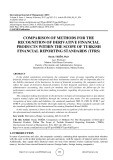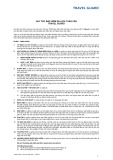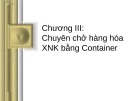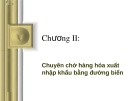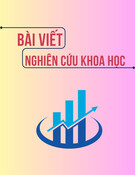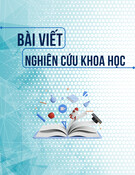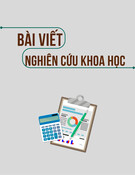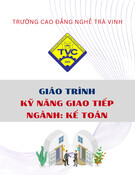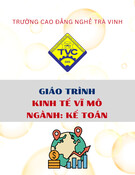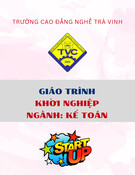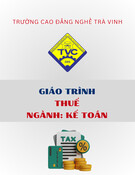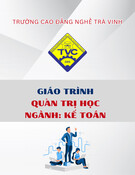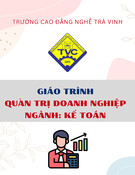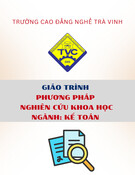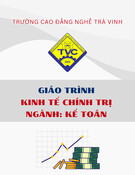
32 Journal of Development and Integration, No. 79 (2024)
No. 79 (2024) 32-36 I jdi.uef.edu.vn
* Corresponding author. Email: thuyht@uef.edu.vn
https://doi.org/10.61602/jdi.2024.78.04
Received: 19-Jun-24; Revised: 31-Jul-24; Accepted: 19-Aug-24; Online: 29-Oct-24
ISSN (print): 1859-428X, ISSN (online): 2815-6234
K E Y W O R D S A B S T R A C T
Sustainable development
goals,
State audit institutions,
Vietnam State
Audit office,
2030 Agenda.
This study examines the pivotal role of Supreme Audit Institutions (SAIs) in monitoring the
implementation of Sustainable Development Goals (SDGs) by governments. Qualitative
research method was used by synthesizing and analyzing important sources of documents
from organizations such as Worldbank, United Nation; Intosai and the website of the
National Supreme Audit Institution to explore the specific functions of the Supreme Audit
Institution towards the goal of sustainable development. The study also pointed out the
challenges faced by SAIs in fulfilling their oversight role and provides recommendations
for strengthening their capacity to support the achievement of the SDGs.
Ha Thi Thuy*
Ho Chi Minh City University of Economics and Finance, Vietnam
The role of supreme audit institutions
in monitoring the implementation of Sustainable
Development Goals by governments
1. Introduction
Since the United Nations (UN) issued 17
sustainable development goals and called on countries
to work together to achieve the goal of protecting the
planet, protecting the environment and quality of life
globally in 2030, Vietnam is one of the countries that
become a member of the United Nations committed
to implementing the 17 goals that have been included
in the 2030 agenda. The goals in the 2030 agenda are
good, but how to monitor countries implementing
the roadmap correctly and effectively requires the
participation and supervision role of the State Audit. This
study was conducted to point out the important role and
challenges of state audit in helping countries effectively
implement the proposed sustainable development
goals. Accordingly, the following sections of the study
will focus on clarifying the following main contents:
(1) An overview of sustainable development goals and
the role of supreme audit institutions in monitoring the
progress of sustainable development goals; (2) Lessons
learned from other countries on the use of supreme
audit institutions in monitoring the implementation
of sustainable development goals; (3) The current
situation in Vietnam; (4) Challenges facing supreme
audit institutions today; (5) Proposing solutions to help
supreme audit institutions improve the effectiveness of
monitoring sustainable development goals.
2. Literature review
2.1. An overview of sustainable development goals
(SDGs)

33
Journal of Development and Integration, No. 79 (2024)
In 2015, the United Nations member states joined
forces to create a roadmap for a better future for all. This
ambitious plan, known as the Sustainable Development
Goals (SDGs), outlines 17 interconnected goals
designed to achieve a world free from poverty, hunger,
natural resources for future generations.
+ Promoting sustainable consumption and
production (Goal 12): Shifting towards practices that
minimize waste and environmental impact.
- Prosperity: The SDGs acknowledge that economic
development is essential for achieving sustainability.
They aim to:
+ Foster decent work and economic growth (Goal
8): Creating opportunities for everyone to have secure
and fulfilling employment.
+ Build resilient infrastructure and promote
innovation (Goal 9): Developing infrastructure that
can withstand environmental challenges and fostering
technological advancements for a sustainable future.
+ Reduce inequalities within and among countries
(Goal 10): Closing the gap between rich and poor, both
within and between nations.
- Partnership: The SDGs acknowledge that achieving
these goals necessitates collaboration.
+ Partnerships for the Goals (Goal 17): Encouraging
partnerships between governments, businesses, and
civil society organizations to share resources, expertise,
and best practices for implementing the SDGs.
2.2. An overview of Supreme Audit Institutions
Supreme Audit Institutions (SAIs) are public
bodies responsible for the audit of government
revenue and expenditure. By scrutinizing public
financial management and reporting they provide
assurance that resources are used as prescribed. SAIs
undertake financial audits of organizations’ accounting
procedures and financial statements, and compliance
audits reviewing the legality of transactions made by
the audited body. The also conduct performance audits
to scrutinize the efficiency, effectiveness or economy of
government’s undertakings (INTOSAI Development
Initiative, 2021).
2.3. The role of State Audit in monitoring sustainable
development goals
Traditional state audit functions focus on financial
accountability. However, for SDGs, their role expands
to and likely relate to performance Auditing (INTOSAI
Development Initiative, 2021).
Promoting Transparency and Accountability: Audits
assess if government policies, programs, and budgets
are aligned with the SDGs. This transparency fosters
public trust and ensures resources are used efficiently
Figure 1. 17 Sustainable Development Goals
(United Nations, 2015)
and inequality, while protecting our planet.
The Sustainable Development Goals (SDGs) have
a broad scope, encompassing a wide range of social,
economic, and environmental issues (United Nations,
2015)
- People: Several goals prioritize human well-being
and equality. This includes:
+ Ending poverty and hunger (Goals 1 & 2):
Ensuring everyone has access to basic necessities like
food, shelter, and sanitation.
+ Promoting good health and education (Goals
3 & 4): Guaranteeing access to quality healthcare,
education, and mental well-being for all ages.
+ Achieving gender equality (Goal 5): Eliminating
discrimination against women and girls and empowering
them to reach their full potential.
+ Building peaceful and inclusive societies (Goal
16): Promoting peace, justice, and strong institutions
for everyone’s safety and security.
- Planet: Recognizing the importance of a healthy
environment, the SDGs address:
+ Combating climate change (Goal 13): Taking
urgent action to reduce greenhouse gas emissions and
adapt to climate impacts.
+ Protecting biodiversity and ecosystems (Goals
14 & 15): Conserving our oceans, forests, and other
Ha Thi Thuy

34 Journal of Development and Integration, No. 79 (2024)
for achieving these goals. Audits can identify potential
misuse or misallocation of funds intended for SDG-
related projects.
Evaluating Effectiveness and Efficiency: Audits
determine if SDG-related programs are being
implemented effectively and efficiently. This helps
identify areas for improvement and prevents wasted
resources. Audits can analyze if programs are truly
achieving their intended outcomes in terms of
contributing to specific SDGs. (Kardos M, 2012).
Highlighting Risks and Challenges: Audits can
identify potential roadblocks to SDG implementation,
such as: Weak governance structures; Corruption;
Inadequate data collection on progress. By bringing
these issues to light, audits pave the way for corrective
measures and improved strategies.
Measuring Progress: Audits provide independent
verification of progress made towards achieving the
SDGs. This quantitative data is essential for: Tracking
progress on specific targets; Identifying areas where
further action is needed.
By scrutinizing public financial management and
evaluating government performance against SDG
targets, SAIs contribute to enhancing accountability,
transparency, and effectiveness in achieving sustainable
development (Rajaguguk, 2017)
development, SAIs, and international experiences,
the research aims to identify key issues and propose
strategies for enhancing SAIs’ effectiveness in this
critical area. Document analysis is the primary research
method used to extract relevant information and insights
from various sources.
4. Results
4.1. Auditing relate to SDGs in some countries
- In Brazil:
The Brazilian Court of Auditors (TCU) has conducted
audits on various SDG-related areas, including: Public
education spending and its effectiveness in achieving
SDG 4 (Quality Education); Management of water
resources and sanitation services, contributing to
SDG 6 (Clean Water and Sanitation). During auditing,
these audits have identified inefficiencies and made
recommendations for improvement, leading to better
allocation of resources and progress towards the SDGs
(UNDP, 2018).
- In Kenya:
The Office of the Auditor General (OAG) of Kenya
partnered with the United Nations Development
Programme (UNDP) to develop a guide for auditing
county governments’ performance on SDGs. This
guide provides a framework for OAG auditors to assess
how county governments are integrating the SDGs into
their development plans and budgets. It helps ensure
resources reach local communities and contribute to
achieving the goals.
- In India:
The Comptroller and Auditor General of India
(CAG) has conducted performance audits on various
government programs related to SDGs, such as:
The Mahatma Gandhi National Rural Employment
Guarantee Scheme (MGNREGS), which contributes
to SDG 1 (No Poverty) and SDG 8 (Decent Work and
Economic Growth). The Swachh Bharat Mission (Clean
India Mission), which contributes to SDG 6 (Clean
Water and Sanitation). After auditing, these audits
have highlighted issues like program implementation
delays and gaps in targeting beneficiaries. This informs
corrective measures and more effective program design
to achieve the SDGs.
- In Sweden:
The Swedish National Audit Office (Riksrevisionen)
has conducted audits on the government’s integration
of the SDGs into its national policies and strategies.
Figure 2. Main role of State audit in monitoring SDGs
Ha Thi Thuy
3. Research Method
This study employs a qualitative research
methodology to examine the role and challenges of
Supreme Audit Institutions (SAIs) in monitoring
Sustainable Development Goals (SDGs). By
synthesizing existing literature on sustainable

35
Journal of Development and Integration, No. 79 (2024)
After auditing, these audits have assessed how well
Sweden’s national plans align with the SDGs and
identify areas for improvement. This ensures a more
cohesive approach to achieving the goals.
4.2. State Audit Office of Vietnam in monitoring SDGs
implementation
Vietnam recognizes the importance of the SDGs and
has made significant strides towards achieving them.
The State Audit Office of Vietnam (SAV) plays a crucial
role in monitoring and promoting progress through its
audit practices. The SAV incorporates SDGs into its
audit strategy by focusing on areas directly linked to
specific goals including: (1) Education: Audits might
assess the efficiency and effectiveness of government
spending on education programs, contributing to SDG
4 (Quality Education). (2) Healthcare: Audits could
evaluate the management of public healthcare resources
and accessibility of services, contributing to SDG 3
(Good Health and Well-being). (3) Poverty Reduction:
Audits might examine government programs aimed at
poverty alleviation and social safety nets, contributing
to SDG 1 (No Poverty). (4) Environmental Protection:
Audits could assess environmental regulations and
compliance, contributing to SDG 13 (Climate Action)
and SDG 15 (Life on Land).
The SAV’s SDG-focused audits have already made
a positive impact during conducting audit, like:
Identifying Inefficiencies: Audits have revealed
areas where government programs can be streamlined
or targeted more effectively to achieve SDG goals.
Promoting Transparency: The SAV’s audit reports
contribute to transparency by highlighting progress
made and areas needing improvement. This fosters
public trust and encourages accountability.
4.3. Challenges in auditing sustainable development
goals
While state audits offer a powerful tool for
monitoring SDG implementation, there are several
challenges SAIs face:
Limited Resources: Conducting comprehensive
audits, especially those encompassing complex topics
like the SDGs, requires significant resources. This
includes well-trained personnel, advanced data analysis
tools, and adequate funding for conducting fieldwork.
Many SAIs, particularly in developing countries, face
budgetary constraints that limit their capacity to conduct
in-depth SDG-focused audits (INTOSAI Development
Initiative, 2021)
Lack of Standardized Methodologies: Currently,
there’s no single universally accepted methodology
for auditing SDG implementation. This can lead to
inconsistencies in how SAIs assess progress across
different countries. Without standardized approaches,
it can be difficult to compare results and share best
practices effectively (INTOSAI Development Initiative,
2021).
Data Availability and Quality: Effective SDG
monitoring relies on robust data collection and
analysis. However, data availability and quality can be
a major challenge, especially for developing countries.
Inconsistent data collection methods, incomplete
datasets, and lack of access to disaggregated data (data
broken down by specific demographics) can hinder the
effectiveness of audits (Reichborn-Kjennerud, K., &
Johnsen, A, 2018)
Political Interference: In some cases, SAIs might
face political pressure that could influence the scope
or outcome of their audits. This can undermine the
independence and objectivity of the audit process.
Ensuring political will and commitment to transparency
is crucial for SAIs to function effectively (UNDESA &
IDI, 2021).
Capacity Building: Auditing SDGs requires
specialized knowledge and skills beyond traditional
financial auditing. SAIs need to invest in training
their staff on the intricacies of the SDGs, social and
environmental auditing methodologies, and data
Figure 3. Main Challenges in auditing
SDGs implementation
Ha Thi Thuy

36 Journal of Development and Integration, No. 79 (2024)
analysis techniques (INTOSAI Development Initiative,
2021).
5. Solutions
To overcome the challenges that auditors are facing
in the process of conducting audits related to sustainable
development goals. Here are some potential solutions
to address the challenges SAIs face in auditing SDGs:
First, about Limited Resources: SAIs can collaborate
with international organizations like the World Bank or
UN agencies to access technical expertise, funding, and
training opportunities. Utilizing data analytics tools and
automation can streamline audit processes and improve
efficiency. SAIs can also strategically prioritize audits
based on national SDG priorities and potential impact
(Chatterjee S, 2018).
Second, about Lack of Standardized Methodologies:
International organizations like INTOSAI can play
a key role in developing and promoting standardized
frameworks for SDG auditing. SAIs can participate in
knowledge-sharing platforms to exchange best practices
in developing and implementing SDG-focused audit
methodologies. Developing and testing pilot SDG
audit methodologies in specific countries can inform
the creation of more standardized approaches.
Third, about Data Availability and Quality: SAIs
can work with national statistical agencies to improve
data collection methods and ensure the availability of
disaggregated data relevant to SDGs. Governments
can invest in developing robust data infrastructure to
improve data collection, storage, and accessibility
for SAIs. SAIs can collaborate with civil society
organizations that might possess data on specific SDG
targets and challenges.
Fourth, about Political Interference: Robust legal
frameworks can safeguard the independence of SAIs
and protect them from political influence. Raising
public awareness about the importance of SAIs and
their role in promoting transparency and accountability
can create a stronger public demand for independent
audits. International organizations can advocate for the
importance of SAI independence and provide support
to SAIs facing political pressure.
Fifth, about Capacity Building: SAIs can invest in
training programs for their staff on the SDGs, social
and environmental auditing methodologies, and data
analysis techniques. Collaboration with international
organizations and SAIs from developed countries can
facilitate knowledge exchange and capacity building for
auditors in developing countries. Mentoring programs
can pair experienced SDG auditors with new staff to
facilitate knowledge transfer and skill development.
6. Conclusion
The ambitious goals outlined in the 2030 Agenda
for Sustainable Development require a multifaceted
approach. State Audit Institutions (SAIs) play a
critical role in ensuring effective implementation of
these goals by acting as guardians of accountability
and transparency. While SAIs offer a powerful tool,
they face challenges like limited resources, lack of
standardized methodologies, and political interference.
Collaboration with international organizations, capacity
building initiatives, and innovative solutions are crucial
to overcome these obstacles. Looking ahead, SAIs are
likely to embrace technological advancements, further
integrate SDG considerations into their work, and
strengthen collaboration with stakeholders. This will
enhance their ability to monitor progress, promote
accountability, and ensure a more sustainable future for
all.
REFERENCES
Chatterjee, S. (2018). Transforming the World Through
Sustainability Efforts. INTOSAI Journal, July.
INTOSAI Development Initiative (2021). Auditing preparedness for
the implementation of the SDGs. A guidance for Supreme Audit
Institutions. Access at https://www.idi.no/elibrary/relevant-sais/
auditing-sustainable-development-goals-programme/1373-
auditing-preparedness-for-implementation-of-sustainable-
development-goals-guidance-for-supreme-audit-institutions-
version-1
Kardos, M. (2012). The reflection of good governance in sustainable
development Strategies. Procedia - Social and Behavioral
Sciences, 58, 1166-1173.
Rajaguguk, B. W., Yatnaputra, G. B. T., Paulus, A. (2017). Preparing
Supreme Audit Institutions For Sustainable Development
Goals. INTOSAI Journal, April.
Reichborn-Kjennerud, K., & Johnsen, A. (2018). Performance
audits and supreme audit institutions’ impact on public
administration: The case of the office of the auditor general in
Norway. Administration & Society, 50(10), 1422-1446.
UNDESA & IDI (2017). Report of the SAI leadership and
stakeholder meeting. New York, 20-21 July.
UNDP (2018). UNCT Brazil SDG Action Plan. MAPS Brazil
engagement report, July.
UNEP (2010). Auditing the Implementation of Multilateral
Environmental Agreements (MEAs). A Primer for Auditors,
Nairobi.
United Nations (2015). Transforming our world: the 2030 Agenda
for Sustainable Development. Resolution A/RES/70/1.
Ha Thi Thuy



